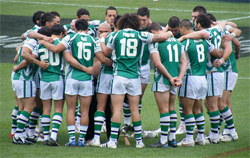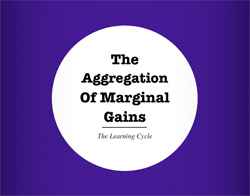
For many educators the professional experience can be a paradoxically lonely one. Teaching is all about communication and relationships, they spend most of their time with large groups of people, yet their position is unique and in many ways isolating. They spend class time as an ‘other’ in a large group of peers, conceptually if not physically alone, and when the classes leave and the work of planning and assessment begins they are often physically alone as well.
The personal implications of this are obvious but there are professional implications as well. In an isolated situation is is hard to develop and progress in what you are doing, as the impetus to do so must come entirely from within, and the models and ideas for next steps must be created from nothing or very deliberately sought out. Why else are so many teachers eagerly communicating through platforms such as twitter, blogs and other social media? Developing on your own is hard, and truly moving forward often requires the ideas, encouragement and challenge of others.
Photo credit: Naparazzi
There is a cool little video that is currently going viral at the moment called 'Caine's Arcade'.
Many of the messages about learning are far too explicit for me to explain here… pretty much everybody will see that it is a parable on the theme of creativity. However, there are also other, more implicit, messages for those of us “in the business of learning”.

After watching ‘Road to Glory’, about the inexorable progress of the Sky Pro Cycling team, it foregrounded the mantra of “The Aggregation of Marginal Gains” that is at the core of David Brailsford’s philosophy.
In essence, it is the drive to perfect every controllable detail in the process of performance – the ‘marginal gains’ – with the result being a cumulative significant gain.
Watching Bradley Wiggins in the Tour de France, as well as the Great Britain cycling team in the 2012 Olympics was nothing short of inspirational – like most teachers it was considering how to harness the idea to make it useful in my teaching.

For many years the teaching profession has been familiar with the term ‘best practice’; sharing what is working well in one setting so that it might be implemented in another. It is happening within schools, between schools at conferences and TeachMeets, and online through both ‘top-down’ websites and ‘bottom up’ blogs from teachers.
Even the recent review of the English National Curriculum has been influenced by a comprehensive review of ‘best practice’ in different subjects from across the world (DfE, 2012). There is a problem with taking such practice at face value. The ‘best practice’ that is often held up is Finland due to the high levels achieved in international PISA league tables (OECD, 2009). However, when looking at international comparisons ’best practice’ is only part of the story. Practice in schools is coupled with the Finnish culture, which places a high value on academic achievement, and a high status for their teaching profession. How can we replicate Finnish achievement unless we take the complexities of Finnish culture and implant them on the English?

Year 6 child: ‘Miss, do you think God is real?’
Year 4 child: ‘Miss, what is the answer?’
Among the many useful pedagogical skills we can learn from the Ancient Greek philosopher Socrates, one of the most interesting is that of Socratic irony.
The Chambers dictionary says that Socratic irony is "a means by which a questioner pretends to know less than a respondent, when actually he knows more."
[Source: Wikipedia]
Zoe Williams, of the Guardian, says that "The technique [of Socratic irony], demonstrated in the Platonic dialogues, was to pretend ignorance and, more sneakily, to feign credence in your opponent's power of thought, in order to tie him in knots."

At the core of all drama is the concept of shared experience: of sharing thoughts, feelings, ideas, opinions and information. Drama also, by its very nature, encourages participants to explore personal and social issues and builds self-esteem. But drama is at its most effective when used in the primary classroom to support and enhance thinking and learning.
For example, when reading and discussing the traditional story of Goldilocks and the Three Bears, drama could be used to explore behaviour by placing certain characters from the story on the ‘hotseat’ – this can involve either the teacher or pupils working in role.

Politicians often remind us that we live in a modern world. A modern world, they say, requires a modern approach.
The first statement - that we live in a modern world - is so obvious that one is tempted to accept the second as equally self-evident, when in fact it is not.
The fact that a thing or idea is new or recent (which is all "modern" means) does not necessarily make it better than something older.
Of course, those in power want us to think that it does, because they want to bring in their own new ideas, or have recently done so. For them, admitting the superiority of an older way of doing things would mean conceding that there is no need for their new ideas (and no need for us to pay for them) or that the ideas they recently introduced have failed.
So they don't admit it. Instead they try to trick us into thinking that newer is always better: they use words such as modern and progressive as if they were synonymous with good; they scorn opponents for wanting to "turn back the clock", as if doing so would be unquestionably bad.
The education discussions, in the online space, are filled with efforts to find the appropriate role for technology in the classroom. No longer are desktop and laptop computers the main focus; it is the new "kids" on the block, such as the iPhone, iPod and iPad, that have moved the discussion ahead at warp speed. Mobile devices, no matter how excellent, are not an answer onto themselves -- they have to fit into the holistic concept of a teaching system. In response, teachers are literally grappling with these new platforms vis a vis teaching and their integration into the classroom.
In our last post, we discussed how to use apps more effectively and what to look for in a mobile app to achieve better memory retention and thus a higher learning acumen. A couple of questions remain; what does an effective, study-enhancing app really look like and how would it function?
No one can argue that Apple's mobile devices (iPhone, iPod, and iPad) have revolutionized educational technology in the past four years. Web-based applications, compared to mobile apps, look and feel 'old' already--maybe even passé. Most of the advice about mobile apps that we have encountered is focused on the delivery of content and how amazing that is in and of itself. The apps purport to improve upon the teacher's job and the curriculum. But, as an avid educational app user/teacher and app developer, we would like to focus on something entirely different; that is, how to effectively use mobile devices and apps as instruments to help improve study skills and improve learning overall.

A community-driven platform for showcasing the latest innovations and voices in schools
Pioneer House
North Road
Ellesmere Port
CH65 1AD
United Kingdom